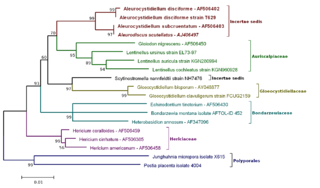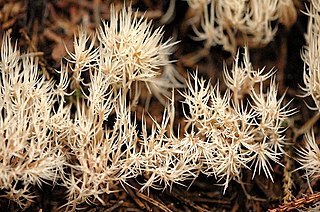Related Research Articles

The Russulales are an order of the Agaricomycetes,. According to the Dictionary of the Fungi, the order consists of 12 families, 80 genera, and 1767 species. According to Species Fungorum, the order contains 13 families, 117 genera, and 3,060 species.

Stereum is the type genus of the Stereaceae family of fungi, in the Russulales order. Until recently, the genus was classified in the Corticiaceae family, of the Corticiales order. However, it was given its own family as a result of the split-up of the Corticiales. Common names for species of this genus include leaf fungus, wax fungus, and shelf fungus. Fungi having a shape similar to a Stereum are said to have a stereoid shape. Stereum contains 27 species that have a widespread distribution.

Silver leaf is a fungal disease of trees caused by the fungal plant pathogen Chondrostereum purpureum. It attacks most species of the rose family Rosaceae, particularly the genus Prunus. The disease is progressive and often fatal. The common name is taken from the progressive silvering of leaves on affected branches. It is spread by airborne spores landing on freshly exposed sapwood. For this reason cherries and plums are pruned in summer, when spores are least likely to be present and when disease is visible. Silver Leaf can also happen on poming fruits like apples and pears. Plums are especially vulnerable.

Lentinellus is a genus of white rot, wood decay, lamellate agaric in the family Auriscalpiaceae, further characterized in part by rough-walled, amyloid spores produced on lamellae with jagged edges. Typically, thick-walled hyphae in the fruit body are in part amyloid, and frequently the taste of the mushrooms is acrid. The widespread genus has been estimated to contain 15 species. Mycologists Ronald Petersen and Karen Hughes considered 24 species in their 2004 world monograph of the genus.

Aleurocystidiellum is a fungal genus of uncertain familial placement in the order Russulales. The type species, Aleurocystidiellum subcruentatum is a crust fungus that was first described in 1860 by Miles Berkeley and Moses Ashley Curtis. Aleurocystidiellum was circumscribed by Paul Arenz Lemke in 1964.

The Pterulaceae are a family of fungi in the order Agaricales. According to a 2008 estimate, the family contained 99 species previously distributed among 12 genera. More recent data from molecular phylogenetic reconstruction showed that members of the genus Parapterulicium are unrelated to Pterulaceae and also polyphyletic. A new genus Baltazaria was created and both genera were moved to Russulales, to families Lachnocladiaceae and Peniophoraceae respectively.
Gloeohypochnicium is a genus of wood-inhabiting crust fungi of uncertain familial placement in the order Russulales. Originally conceived by Erast Parmasto as a subgenus of Hypochnicium, Kurt Hjortstam considered it worthy of distinct generic status in 1987. The type species, G. analogum, was described as new to science in 1913 by French mycologists Hubert Bourdot and Amédée Galzin as a species of Gloeocystidium. G. versatum was added to the genus in 2010.
Lactarius cyanescens is a member of the large milk-cap genus Lactarius in the order Russulales. It was first described as new to science in 2007.

The hydnoid fungi are a group of fungi in the Basidiomycota with basidiocarps producing spores on pendant, tooth-like or spine-like projections. They are colloquially called tooth fungi. Originally such fungi were referred to the genus Hydnum, but it is now known that not all hydnoid species are closely related.
Lactarius acicularis is a member of the large milk-cap genus Lactarius in the order Russulales. Described as new to science in 2010, the species is found in Chiang Mai Province of northern Thailand, where it grows in rainforests that are dominated by Castanopsis armata, Dipterocarpus sp. and Lithocarpus. The specific epithet, acicularis, is derived from Latin and means "needle-shaped".
Lactarius crocatus is a member of the large milk-cap genus Lactarius in the order Russulales. Found in Chiang Mai Province, it was described as new to science in 2010.
Lactarius distantifolius is a member of the large milk-cap genus Lactarius in the order Russulales. Found in Chiang Mai Province, it was described as new to science in 2010. The fruit bodies of the fungus were found growing in a teak plantation with Dipterocarpus obtusifolius and other Dipterocarpus species, Pterocarpus macrocarpus, and Shorea species.
Lactarius longipilus is a member of the large milk-cap genus Lactarius in the order Russulales. Found in Chiang Mai Province, it was described as new to science in 2010. The mushrooms were found at an elevation of 1,300 metres (4,300 ft) growing in a forest dominated by Castanopsis spp., Lithocarpus sp., and Pinus kesiya.
Lactarius pinguis is a member of the large milk-cap genus Lactarius in the order Russulales. Found in northern Thailand, it was described as new to science in 2010.
Lactarius vitellinus is a member of the large milk-cap genus Lactarius in the order Russulales. Found in northern Thailand, it was described as new to science in 2010.

Lactarius maculatipes is a member of the large milk-cap genus Lactarius in the order Russulales. The species was described as new to science by mycologist Gertrude S. Burlingham in 1942.
Lactarius villosus is a member of the large milk-cap genus Lactarius in the order Russulales. Found in Nebraska, the species was described in 1896 by Frederick Edward Clements.
Václav Melzer was a Czech teacher and mycologist, who was part of a group of Czech teachers who became mycologists at the beginning of the 20th century that also included figures such as Jindřich Kučera, Rudolf Veselý, and František Tyttl. A substantial part of his life was spent living and working in Domažlice.
Lactarius baliophaeus is a member of the large milk-cap genus Lactarius in the order Russulales. Described as new to science by mycologist David Pegler in 1969, the species is found in Ghana, Benin, and Zambia. Fruitbodies of the type collection were found growing in the ground under Cassia. It is closely related to Lactarius subbaliophaeus, a species described from Togo in 2014. Both are classified in Lactarius section Nigrescentes. L. baliophaeus is edible and used as food.
Lactarius subbaliophaeus is a member of the large milk-cap genus Lactarius in the order Russulales. Found in Togo, it was described as new to science in 2014 by Dao Lamèga Maba and Nourou Yorou. It is named for its similarity to the more widespread African species L. baliophaeus. L. subbaliophaeus produces a white latex which, upon exposure to air, changes color to pinkish and then blackish.
References
- 1 2 3 Leal-Dutra, Caio A.; Neves, Maria Alice; Griffith, Gareth W.; Reck, Mateus A.; Clasen, Lina A.; Dentinger, Bryn T. M. (2018-07-31). "Reclassification of Parapterulicium Corner (Pterulaceae, Agaricales), contributions to Lachnocladiaceae and Peniophoraceae (Russulales) and introduction of Baltazaria gen. nov". MycoKeys. 37 (37): 39–56. doi: 10.3897/mycokeys.37.26303 . ISSN 1314-4057. PMC 6081468 . PMID 30116138.
- ↑ "Species Fungorum - Parapterulicium". www.speciesfungorum.org. Retrieved 2022-07-10.